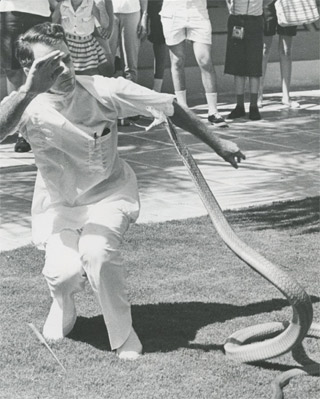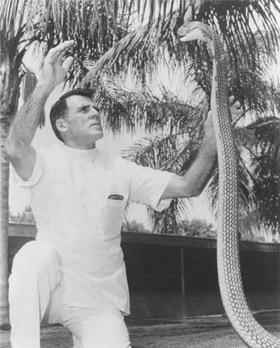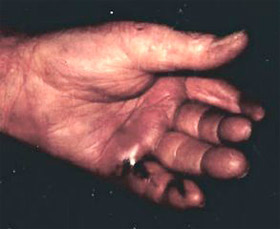
Associated Press Photo
People over the years have always expressed immense curiosity about Bill's ability to survive so many venomous snakebites, and wonder at such a high count; while the number is approximately 172, it is an approximation because he never counted scratches, a glancing bite or a one-fang injection from adult or juvenile specimens where he didn't receive a significant amount of venom as legitimate enough to be added to the tally.
The number of bites was not something he was proud of, although surviving them he was; more than 20 were nearly fatal and he always viewed each one as the result of a lack of proper attention. In his defense, however, he remarked that taking into account the law of averages, and with 172 (or so) snakebites (one was a lizard, see In The Press) that occurred in the process of handling well over two million venomous reptiles, his average was better than any baseball player's.
Included in that amazing tally of handlings were the three king cobras brought out each sunday, one after each venom collection demonstration as an extra added attraction or that he normally kept for venom production even after the public part of his work ended. Weekly handlings of three of the formidable reptiles (considered the most dangerous animals in the world) for over 50 years amounted to more than 7,000 king cobra catches from snakes averaging 13 feet in length, with only three bites in all that time. It was a remarkable testament to his handling skills. And of course, it is most remarkable that he survived even one, a snake capable of delivering enough venom in a bite to kill an elephant.

Miami Metro Dept. of Publicity & Tourism
He really was displeased with himself after a bite, to be sure. Whether or not it was disappointment from the fact that he let his guard down or allowed himself to be distracted in some way, which the snake never was except at Bill's direction, at the bottom of his angst was the loss of time it would represent, for slowing down for anything was just the most unpleasant experience, never mind the pain and potential loss of limb and life. That stop in the effort to move forward was the real annoyance.
He always vowed after a snakebite never to lose the battle of reflexes again, but, the law of averages was not to be denied, and inevitably the next bite would occur once more. Generally the more snakes he handled, especially when on a large-scale project to produce great quantities of venom in a short amount of time, the more frequent the occurrence of the bites, it just happened that way.
Back to the question about how he survived any snakebite, let alone so many. First, not all venomous snakes are capable of injecting lethal quantities of venom in a bite, either because of size or potency of the venom, but most, absolutely most of the snakes that Bill did handle were quite capable of injecting lethal or multiple lethal doses in a bite. In more recent years the hypothesis about snakes delivering "dry" bites has become common, but Bill never saw one of those in more than two million handlings, unless the snake's fangs were missing or something was physiologically wrong with the glands, etc. Having been on the receiving end of snakes' intentionality more than 172 times, he found such a concept amusing.
As the illustrious author of "The Outermost House" (1928), Henry Beston wrote:
"We need another and a wiser and perhaps a more mystical concept of animals. Remote from universal nature and living by complicated artifice, man in civilization surveys the creature through the glass of his knowledge and sees thereby a feather magnified and the whole image in distortion.
We patronize them for their incompleteness, for their tragic fate for having taken form so far below ourselves. And therein do we err. For the animal shall not be measured by man. In a world older and more complete than ours, they move finished and complete gifted with the extension of the senses we have lost or never attained, living by voices we shall never hear. They are not brethren, they are not underlings; they are other nations, caught with ourselves in the net of life and time, fellow prisoners of the splendour and travail of the earth."*

Very soon after he began the Miami Serpentarium and started importing the top-most deadly snakes of the world, he knew that a bite from any one of them could end his dream before it began. He also knew the basic process of antivenin production, and it was quite logical to assume that if horses could build up antibodies to snake venom proteins, why not he. So as a matter of self preservation, but perhaps more significant to Bill, to satisfy that intense scientific curiosity to see if it could be done and as always, challenge himself to the utmost, he began his immunization program on Sept. 10, 1948. He began with the injection of a highly diluted amount of cobra venom, and slowly over time added additional species until in later years he was receiving a mixture of over 30 different venoms in an injection once a week.

144th error in judgement,
Eastern diamondback rattlesnake 11/87
There were critics of his attempt at the time, one of whom remarked that he wouldn't give a nickel for Bill living three years; others expressed concern about what injecting such potent substances into a person's system might do to the internal organs. For many people that would be a legitimate concern, but Bill crossed the finish line of the marathon of life at the venerable age of 100, and until then, his organs were working just fine.
Of the approximately 172 venomous snakebites, all but the last few which came later were validated by the Guinness Book of World Records, a process which Bill found particularly distasteful as he did not consider his mistakes a goal to be attained or admired but rather a number representing what he considered to be errors in judgement.
* Sincere appreciation is given to Kate Beston Barnes for permission to print this passage from her father's remarkable works.